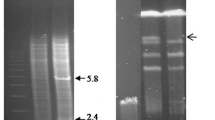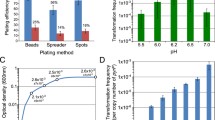Summary
The DNA sequences of the mercuric resistance determinants of plasmid R100 and transposon Tn501 distal to the gene (merA) coding for mercuric reductase have been determined. These 1.4 kilobase (kb) regions show 79% identity in their nucleotide sequence and in both sequences two common potential coding sequences have been identified. In R100, the end of the homologous sequence is disrupted by an 11.2 kb segment of DNA which encodes the sulfonamide and streptomycin resistance determinants of Tn21. This insert contains terminal inverted repeat sequences and is flanked by a 5 base pair (bp) direct repeat. The first of the common potential coding sequences is likely to be that of the merD gene. Induction experiments and mercury volatilization studies demonstrate an enhancing but non-essential role for these merA-distal coding sequences in mercury resistance and volatilization. The potential coding sequences have predicted codon usages similar to those found in other Tn501 and R100 mer genes.
Similar content being viewed by others
References
Barnes WM, Bevan M, Son PH (1983) Kilo-sequencing: Creation of an ordered nest of asymmetric deletions across a large target sequence carried on phage M13. Methods Enzymol 101:98–122
BarrineauPJ, Summers AO (1983) A second positive regulatory function in the mer (mercury resistance) operon. Gene 25:209–221
Barrineau P, Gilbert P, Jackson WJ, Jones CS, Summers AO, Wisdom S (1984) The DNA sequence of the mercury resistance operon of the IncFII plasmid NR1. J Mol Appl Genet 2:601–619
Brown NL, Ford SJ, Pridmore RD, Fritzinger DC (1983) Nucleotide sequence of a gene from the Pseudomonas transposon Tn501 encoding mercuric reductase. Biochemistry 22:4089–4095
Brown NL, Winnie JN, Fritzinger D, Pridmore RD (1985) The nucleotide sequence of the tnpA gene completes the sequence of the Pseudomonas transposon Tn501. Nucleic Acids Res 13:5657–5669
Clark DL, Weiss AA, Silver S (1977) Mercury and organomercurial resistance determined by plasmids in Pseudomonas. J Bacteriol 132:186–196
de la Cruz F, Grinsted J (1982) Genetic and molecular characterization of Tn21, a multiple resistance transposon from R100.1. J Bacteriol 151:222–228
Diver WP, Grinsted J, Fritzinger DC, Brown NL, Altenbuchner J, Rogowsky P, Schmitt R (1983) DNA sequences of and complementation by the tnpR genes of Tn21, Tn501 and Tn1721. Mol Gen Genet 191:189–193
Ebright RH (1985) Proposed amino acid-base pair contacts for thirteen sequence-specific DNA binding proteins. In: Oxender D (ed) Protein structure, folding, and design. Alan R. Liss, New York, in press
Foster TJ (1983) Plasmid-determined resistance to antimicrobial drugs and toxic metal ions in bacteria Microbiol Rev 47:361–409
Foster TJ, Brown NL (1985) Identification of the merR gene of R100 by using mer-lac gene and operon fusions. J Bacteriol 163:1153–1157
Foster TJ, Nakahara H, Weiss AA, Silver S (1979) Transposon A-generated mutations in the mercuric resistance genes of plasmid R100-1. J Bacteriol 140: 167–181
Grinsted J, Brown NL (1984) A Tn21 terminal sequence in Tn501: Complementation of tnpA gene function and transposon evolution. Mol Gen Genet 197:497–502
Haas D, Cryz SJ Jr, Itoh Y, Leisinger T, Luthi E, Mercenier A, Reimmann C, Rella M, Soldati L, Watson JM, Wretlind B (1984) Some applications of transposon insertion mutagenesis in Pseudomonas. In: Heslot H (ed) Genetique des micro-organismes industriels. Societe Francaise de Microbiologie, Paris, pp 91–111
Itoh Y, Haas D (1985) Cloning vectors derived from the Pseudomonas plasmid pVS1. Gene 36:27–36
Itoh Y, Watson JM, Haas D, Leisinger T (1984) Genetic and molecular characterization of the Pseudomonas plasmid pVS1. Plasmid 11:206–220
Jackson WJ, Summers AO (1982) Biochemical characterization of HgCl2-inducible polypeptides encoded by the mer operon of plasmid R100. J Bacteriol 151:962–970
Lund PA, Ford SJ, Brown NL (1985) Transcriptional regulation of the mercury-resistance genes of transposon Tn501. J Gen Microbiol, in press
Messing J, Crea R, Seeburg PH (1981) A system for shotgun DNA sequencing. Nucleic Acids Res 9:309–321
Misra TK (1985) A new strategy to create ordered deletions for rapid nucleotide sequencing. Gene 34:263–268
Misra TK, Brown NL, Fritzinger DC, Pridmore RD, Barnes WM, Haberstroh L, Silver S (1984) Mercuric ion-resistance operons of plasmid R100 and transposon Tn501: The beginning of the operon including the regulatory region and the first two structural genes. Proc Natl Acad Sci USA 81:5975–5979
Misra TK, Brown NL, Haberstroh L, Schmidt A, Goddette D, Silver S (1985) Mercuric reductase structural genes from plasmid R100 and transposon Tn501: functional domains of the enzyme. Gene 34:253–262
Nakahara H, Silver S, Miki T, Rownd RH (1979) Hypersensitivity to Hg2+ and hyperbinding activity associated with cloned fragments of the mercurial resistance operon of plasmid NR1. J Bacteriol 140:161–166
NíBhriain N (1985) Molecular genetic analysis of the mercury resistance (mer) operon of plasmid R100. Ph D Thesis, Trinity College, Dublin
NíBhriain N, Silver S, Foster TJ (1983) Tn5 insertion mutations in the mercuric ion resistance genes derived from plasmid R100. J Bacteriol 155:690–703
Pabo CO, Sauer RT (1984) Protein-DNA recognition. Annu Rev Biochem 53:293–321
Robinson JB, Tuovinen OH (1984) Mechanisms of microbial resistance and detoxification of mercury and organomercury compounds: Physiological, biochemical and genetic analyses. Microbiol Rev 48:95–124
Rogowsky P, Schmitt R (1984) Resolution of a hybrid cointegrate between transposons Tn501 and Tn1721 defines the recombination site. Mol Gen Genet 193:162–166
Sanger F, Nicklen S, Coulson AR (1977) DNA sequencing with chain-terminating inhibitors. Proc Natl Acad Sci USA 74:5463–5467
Stanisich VA, Bennett PM, Richmond MH (1977) Characterization of a translocation unit encoding resistance to mercuric ions that occurs on a nonconjugative plasmid in Pseudomonas aeruginosa. J Bacteriol 129:1227–1233
Stormo GD, Schneider TD, Gold LM (1982) Characterization of translational initiation sites in E. coli. Nucleic Acids Res 10:2971–2996
Summers AO, Silver S (1978) Microbial transformations of metals. Annu Rev Microbiol 32:637–672
Wilbur WJ, Lipman DJ (1983) Rapid similarity searches of nucleic acid and protein data banks. Proc Natl Acad Sci USA 80:726–730
Author information
Authors and Affiliations
Additional information
Communicated by D. Goldfarb
Rights and permissions
About this article
Cite this article
Brown, N.L., Misra, T.K., Winnie, J.N. et al. The nucleotide sequence of the mercuric resistance operons of plasmid R100 and transposon Tn501: further evidence for mer genes which enhance the activity of the mercuric ion detoxification system. Mol Gen Genet 202, 143–151 (1986). https://doi.org/10.1007/BF00330531
Received:
Issue Date:
DOI: https://doi.org/10.1007/BF00330531




